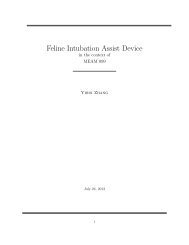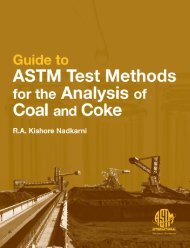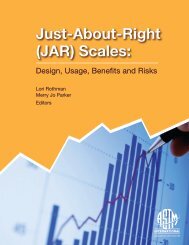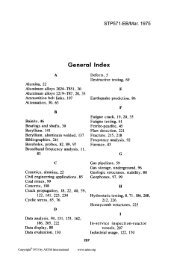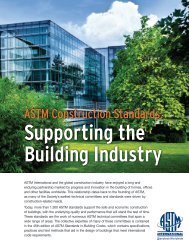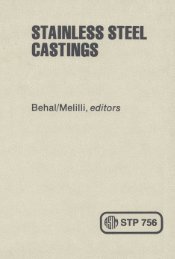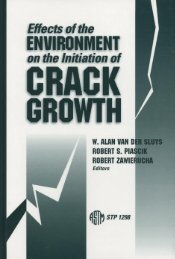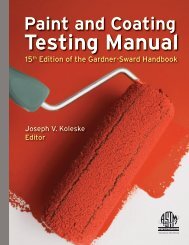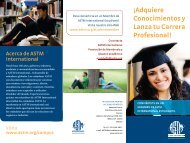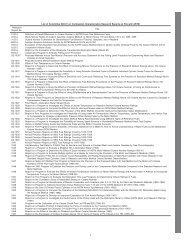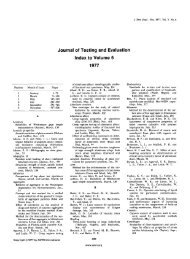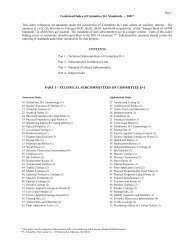Form and Style for ASTM Standards - ASTM International
Form and Style for ASTM Standards - ASTM International
Form and Style for ASTM Standards - ASTM International
Create successful ePaper yourself
Turn your PDF publications into a flip-book with our unique Google optimized e-Paper software.
E3. Guidelines <strong>for</strong> Writing Definitions of<br />
Terms <strong>and</strong> Definitions of Terms Specific to a<br />
St<strong>and</strong>ard<br />
E3.1 Use these guidelines when writing both<br />
definition of terms <strong>and</strong> definitions of terms specific<br />
to a st<strong>and</strong>ard.<br />
E3.2 Prepare a definition when:<br />
E3.2.1 Any term used in a st<strong>and</strong>ard is<br />
essential to the interpretation <strong>and</strong> application of<br />
the st<strong>and</strong>ard;<br />
E3.2.2 A term used in a st<strong>and</strong>ard is not<br />
adequately defined in common language;<br />
E3.2.3 Using qualitative adjectives <strong>and</strong><br />
nouns that could be taken to denote or connote an<br />
absolute, unqualified, orunconditional property<br />
or capability; <strong>for</strong> example: waterproof, stainless,<br />
unbreakable, vapor barrier, gas-free, flat, safe,<br />
rigid, pure. Such qualitative adjectives <strong>and</strong> nouns<br />
shall not be used unless actually used <strong>and</strong> defined<br />
in their absolute sense;<br />
E3.2.4 Describing a quantitative determinable<br />
property or capability that might cause<br />
misinterpretation or confusion; <strong>for</strong> example:<br />
strong, high, accurate, clean.<br />
E3.3 Do not develop a definition when:<br />
E3.3.1 A term is adequately defined in<br />
reference source material (print or electronic<br />
version), unless a definition is required <strong>for</strong> clarity;<br />
E3.3.2 A term has a well-recognized<br />
authoritative meaning such as terms defined in<br />
the <strong>International</strong> System of Units (SI);<br />
E3.3.3 A term is defined acceptably <strong>for</strong> the<br />
committee’s purposes in the <strong>ASTM</strong> Dictionary of<br />
Engineering Science & Technology or the committee’s<br />
terminology st<strong>and</strong>ard;<br />
E3.3.4 A term that meets the committee’s<br />
needs has been defined in a technical st<strong>and</strong>ard of<br />
another committee or subcommittee.<br />
E4. <strong>Form</strong> of a Definition<br />
E4.1 Write definitions of terms <strong>and</strong> definitions<br />
specific to a st<strong>and</strong>ard in the dictionarydefinition<br />
<strong>for</strong>m. Include term, part of speech,<br />
definition, <strong>and</strong>, when applicable, a delimiting<br />
phrase (see E5.5).<br />
TERMINOLOGY IN <strong>ASTM</strong> STANDARDS<br />
E-2<br />
E4.2 Describe the essential characteristics of<br />
the term. Keep it simple. Do not include irrelevant<br />
details such as how things are made, used,<br />
or measured.<br />
E4.3 State the definition without repeating<br />
the term defined. Use language that is underst<strong>and</strong>able<br />
to non-experts.<br />
E4.4 Complete the definition in one sentence.<br />
If two or more phrases are needed to state<br />
the meaning, connect them with semicolons.<br />
Include any necessary supplementary in<strong>for</strong>mation<br />
as a Discussion.<br />
E4.5 The term <strong>and</strong> its elements should<br />
appear in the following order: term; abbreviation;<br />
symbol; dimensions of quantities, measurement<br />
units; part of speech; delimiting phrase; statement<br />
of meaning, including specification limits where<br />
applicable; cross-references to synonyms or<br />
related terms; attribution.<br />
E5. Elements of a Term<br />
E5.1 Abbreviations— For terms usually represented<br />
by an abbreviation, place a comma <strong>and</strong><br />
the preferred abbreviation following the term,<br />
<strong>and</strong> then the part of speech, <strong>for</strong> example:<br />
average, avg, n—<br />
E5.2 Symbols— For terms usually represented<br />
by a letter symbol, place a comma <strong>and</strong> the<br />
preferred symbol following the term, <strong>and</strong> then the<br />
part of speech, <strong>for</strong> example:<br />
ampere, A, n—<br />
E5.3 Dimensions of Physical Quantities—If<br />
the term represents a physical quantity, state its<br />
analytical dimension in italics in square brackets<br />
immediately following the letter symbol, or if<br />
there is none, following the term itself, <strong>for</strong><br />
example:<br />
critical height, H c[L],n—in earth grading, the maximum<br />
height at which a vertical or sloped bank of soil will st<strong>and</strong><br />
unsupported under a specific set of conditions.<br />
D653<br />
E5.4 Parts of Speech— Including the part of<br />
speech enables the user to distinguish between<br />
closely allied terms; <strong>for</strong> example:



